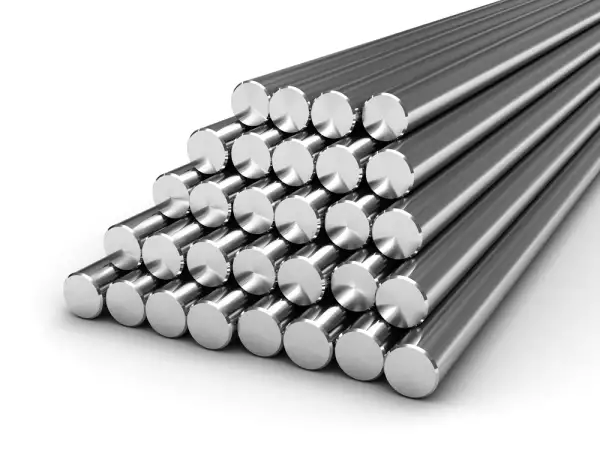From the series of articles "Lightning protection for beginners".
Many years ago, when the studio of scientific popular movies was working in the country, the filmmakers came to our laboratory. They wanted to make a story about the laboratory tests of lightning rods. A decoraton was placed under the generator for 3 million volts (it was fixed to the ceiling and hang upside down). A sparkle of 6 meters in length was successfully intercepted by the model of a rod lightning rod. Now it's time to show a negligent owner, whose house is without a lightning rod. According to the scenario after a lightning strike it should burn. The spark did not miss. It broke through the plywood roof of the scenery and hit the grounded metal floor of the laboratory. there was no flame. we splashed spirit on the roof and repeated the discharge - the same effect. We put a saucer with spirit inside the playhouse and brought a spark through the wire directly to it. It did not help. The filmmakers left with nothing, complaining about the weak capacity of the spark.
The claims to the spark were unreasonable. Its channel temperature was not less than 6000 C, about the same as that of a good welder set. The lifetime of the spark was estimated in tens of microseconds. A powerful current pulse in the lightning channel dures approximately the same. But the fire did not happen, even a toy fire.
The temperature in the real lightning channel was reliably measured by spectroscopic methods. The temperature on the sun's surface was fixed approximately the same way, where it is close to 6000 C like that of the laboratory long spark. Lightning is noticeably hotter. The plasma in its channel is heated up to 30 000 C. Even metal will burn at this temperature. However, experts do not consider lightning to be a very active arsonist.
"There is nothing surprising here," - a astute reader will say - "non-combustible materials are used in modern construction." Indeed, neither brick nor monolithic or precast concrete will burn. But it is not only about the materials. It is worth to recall about the well-established technique of modern fire-fighting crews in the oil or gas fields. In an emergency, they slake the flame over the already unmanageable oiler with a directed blast. The lightning acts the same. With an extremely fast heating of its channel, there appears a shock wave (it makes a thunderclap). The rapid air flow blows the combustion products away. Lightning itself acts as a firefighter. The strength of the shock wave is very large. At a lightning struck into the airscoop of the aircraft it is able to disrupt the flame and stop the turbine.
And yet the fire from contact with the lightning channel is possible, especially if lightning is multicomponent. I advise you to take advantage of the nearest storm to watch lightning strikes hitting the ground. Most channels seem aglimmer. It is not an optical illusion. The thing is that several electric charges can be formed on the same channel - lightning components. They follow each other with a pause to the tenth of a second. If you take a picture of lightning on a slowly moving photographic film (this was possible with the old phot camera with manual film rewind), you will get the following picture:
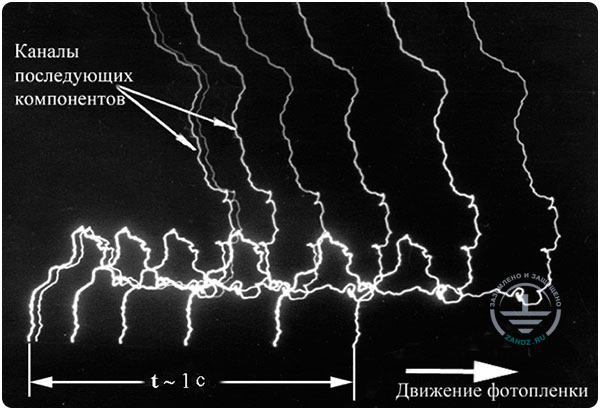
This picture was taken by the experts of the Energy Institute to the name of G.M. Krzyzanowski with a camera of automatic tracking over the Ostankino TV tower
Каналы последующих компонентов – channels of the successive components
Движение фотопленки – photo film movement
This picture was taken by the experts of the Energy Institute to the name of G.M. Krzyzanowski with a camera of automatic tracking over the Ostankino TV tower. The strike consisted of 7 components. Their average number is close to 3-4 and the maximum exceeds 30. Channel glows very brightly only under the effect of a strong lightning current pulse. It creates a shock wave. In the pauses between the components, the current is very weak, but this ''very" is determined in the scale of lightning. The magnitude of the interelement current is in the range of 100 A. It is about the same in the the welding machine arc. The channel brightness weakened, it no longer generates the shock wave and the temperature dropped significantly - to about 6000 - 7000 C. But such a "match" can do a lot, especially after the last component, when the shock wave is already extinguished and can slake nothing. If the material of the building is combustible, as the coating of a recently burnt skyscraper in Grozny, you can immediately dial "01" or "112".
Lightning rods succesfuly solve the problem in the situatio studied. With proper alignment, they practically exclude the lightning channel contact with the protected structure. Unfortunately, the danger of fire won't be eliminated completely. On the picture, you see the fragment of the tank with liquid fuel after a fire in a thunderstorm atmosphere. As you can see, there were lightning rods on the tank. One of them even survived the fire and got into the picture. It did not help to avoid the fire. It's more correct to say it could not help because there was no lightning strike into the tank. At the time the storm has not yet begun. There was a storm situation only. There was a cloud above the tank farm.
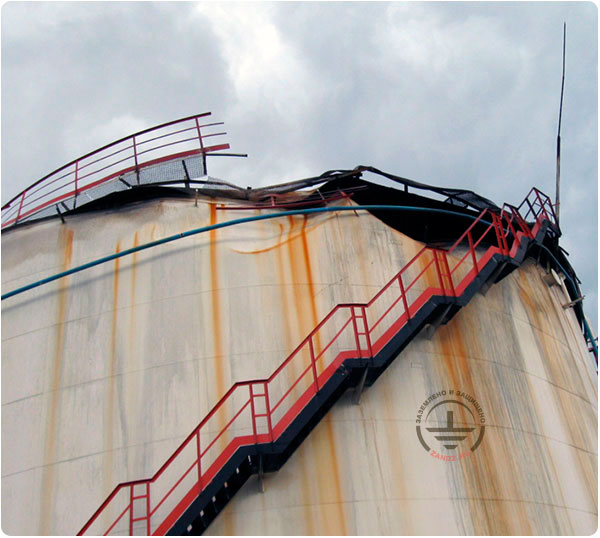
There was a cloud above the tank farm
It was enough.
Most readers of this article were probably fond of pirate novels in the childhood. Their authors could escalate the situation, describing the sinister glow on the tops of the masts of pirate ships in detail. This phenomenon is called St. Elmo's fire. High-voltage engineers call its corona discharge or simply corona. Corona occurs in the electric field of a thunderstorm cloud not only from high ship masts, but also from any high buildings with the top of a small radius, even from supports of lightning rods. The reason of origin of such discharges is simple. A thundercloud creates a very significant electric field at the surface of the earth. Its strength achieves 10 - 50 kV / m. Up to 500 kV can be achieved on a construction a dozen of meters high. This is enough to ionize the air and even form channels tens of centimeters long. And now recollect the perfect functioning of an electrical lighter for a gas stove in your kitchen.
Short spark channels in storm conditions act the same. But they ignite not the gas burner, but the gas mixtures at the pressure vent valves of the petroleum tanks. No need to continue here. If the the fire isolation system of vent valves is not perfect, a major fire will be likely to happen even without a direct lightning strike. Short sparks in hazardous locations of the facility can have an entirely different nature. Lightning current of a great value creates a strong magnetic field. It rapidly changes in time, because the growth rate of the lightning current is able to exceed 1011 A / sec. According to Faraday's law, EMF of magnetic induction occurs in any contour due to the magnetic field. Under unfavorable conditions it is measured in tens of kilovolts, sometimes a lot more than necessary to create a short spark discharge. In an explosive volume it is a direct path to a dangerous trouble. A lightning rod can successfully intercept lightning and divert its current into the ground, but the magnetic field from the current in the support of the lightning rod will remain virtually the same as from the current in the lightning channel. A lightning rod does not eliminate danger. Hopefully, we will return to the electromagnetic field of lightning. Today, it is perhaps the main danger to the modern technology.
At the end of the article, let's talk about another non-standard source of fires. Half a century ago, when there was no space communication, all long-distance calls were made over underground cable telephone networks. Telephone cables often suffered from lightning, especially in soils of low conductivity, rock, or permafrost. Repair crews almost never used tools to search for the damaged site. A small bus on the base of GAZ 51 with the repairers drove along the cable route, until they saw the band of rearing ground, similar to the furrow of the peasant plow. As a rule, it started from a tall tree and broke off at the place of the cable location. After a short work with shovels we see a crumpled cable with the deformed insulation. This is how lightning worked. It stroke into the tallest tree in a fire-break and the lightning current flowed through the roots over the conducting ground. It would be better to say "over a poorly conducting ground" because its resistivity is at least a billion times higher than that of steel. Ohm's law works in the ground. Multiplication of lightning current and resistance gives voltage, multiplication of current density on resistivity - electric field strength. When it exceeds about 106 V / m, ionization begins in the soil begins, which can give start to a spark channel. As a rule, it slides along the soil surface and the loosened strip of land is its result. The stronger is the lightning and the lower is the ground conductivity, the further is the spreading of the sliding channel.
The nature of this phenomenon has been well studied experimentally and theoretically. The figure shows the calculated dependence of the channel length on soil resistivity for lightning of an average strength with a current of 30 kA. It is easy to see that in terms of practical significance, the channels of the sliding discharges grow to several tens of meters, thus penetrating into the zone, well protected by the lightning rods, but not in a traditional way, from above, but bypassing the lightning rods, from below.
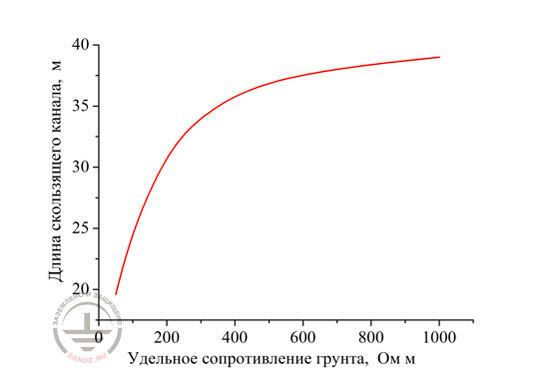
The figure shows the calculated dependence of the channel length on soil resistivity for lightning of an average strength with a current of 30 kA
Длина скользящего канала, м – sliding channel length, m
Удельное сопротивление грунта, Ом м – soil resistivity, Ohm m
It is easy to imagine the consequences of such an event, having noticed that the channel by its nature is arched and is warmed up no less than to 6,000 C.
The moral is simple enough. It is not so easy to set modern structures on fire and a lightning strike into them rarely causes a fire. But if there is a large amount of hydrocarbon fuels or the production is connected with the formation of explosive and flammable dust or gas mixtures in the air, lightning protection requires only a professional attitude. Installation of lightning rods is obligatory here, but it doesn't always solve the problem completely. The lightning armory is diverse, and therefore the choice of protective means must be carried out by a specialist.
E. M. Bazelyan, DEA, professor
Energy Institute named after G.M. Krzyzanowski, Moscow
We hope that in the future this site will perform the role of an elementary textbook for self-defense against lightning. We plan to continually post articles about the real dangers of lightning electricity and modern means of lightning protection here. They are designed to help to sort out the existing problems and to estimate the ways to solve it.
See also:
- Free webinars for project designers with Professor E.M. Bazelyan
- Free webinars for project designers with Dr. M. Loboda
- A series of articles "Lightning protection of oil and gas facilities"
- A series of articles "Lightning protection of residential and public buildings"
- Grounding in lightning protection - answers to frequently asked questions in the design
- Consultations on the selection, design and installation of grounding and lightning protection systems
Related Articles:
 Grounding in the cellar of the single-family house - is it possible?
Grounding in the cellar of the single-family house - is it possible?


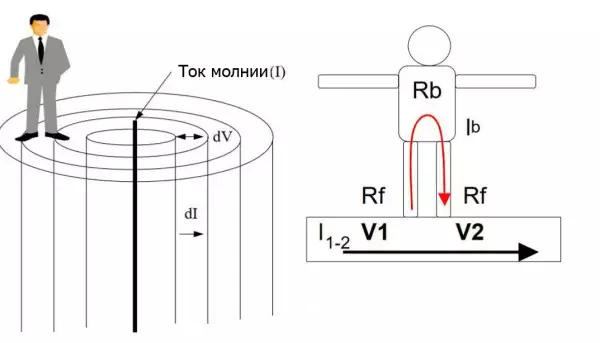 Step Voltage: Dangerous Obscurity and Reliable Protection
Step Voltage: Dangerous Obscurity and Reliable Protection
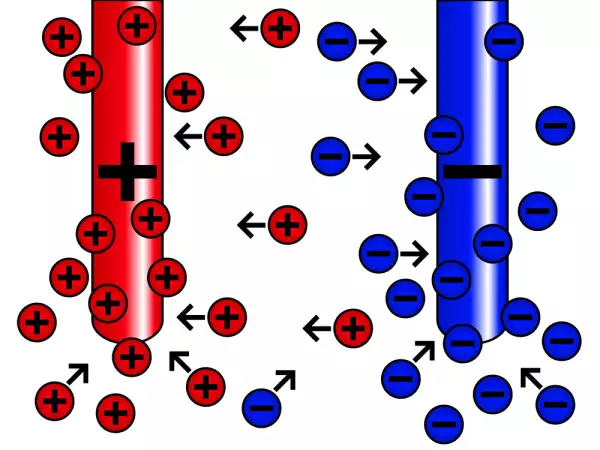 Nature of Electrochemical Corrosion
Nature of Electrochemical Corrosion
 Public Safety in Land Transport in case of Direct Lightning Strike
Public Safety in Land Transport in case of Direct Lightning Strike
